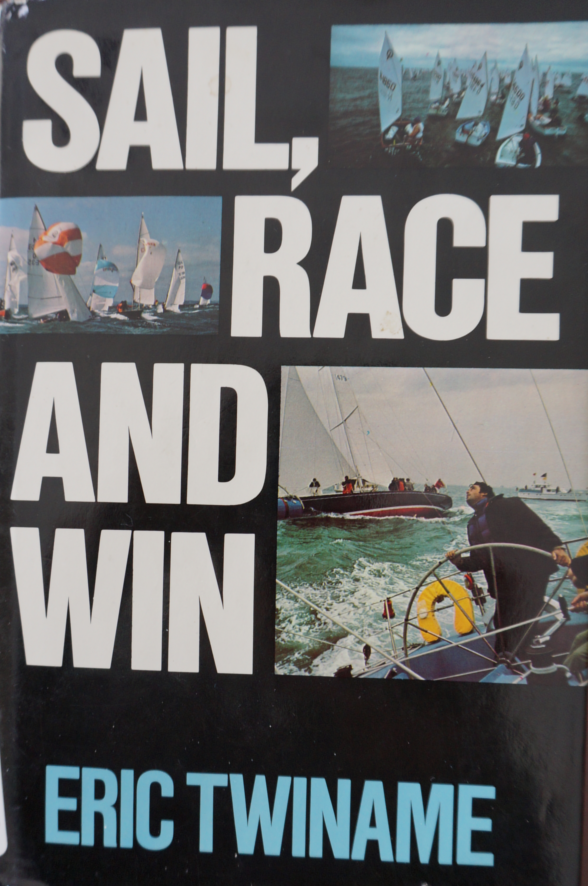A Different Kind of Sailing Book
Eric Twiname’s Sail, Race and Win might be the best book available about becoming a better sailor. It doesn’t focus much on sailing technique. Instead, it shows how to teach yourself to win. If you are serious about improvement, this short book is for you.
This post was published previously. With the start of the summer sailing season, we updated it as a reminder to keep improving.
Become Your Own Coach
Twiname wants you to transform “book knowledge” into action. You do this by becoming your own coach – assessing weaknesses, setting priorities, and developing ways to learn. This focus is evident in the chapter titles:
- Teach yourself to win
- The secrets of losing
- A plan of attack
- The art of learning
- Ways of learning
- Making your self-coaching plan
- Survival racing
- Researching success
- Reinforcing success
- Mastering close quarter tactics
- Good practice makes perfect
- Paired practice
- Physical fitness
- Mental fitness
- Psychological barriers to winning
- Making the least of crises
- Mental preparation
- Preparing for major combat
Four Key Insights
Sail, Race and Win has many inspiring insights. Here are just four that stood out for this reviewer.
Practice Makes Perfect
Too many sailors rely on racing alone to improve. This does not work in other sports and won’t work in sailing. Focused practice – breaking down a skill until you can perform it perfectly without thinking – is the best way to improve.
Set Priorities
Twiname says to identify three areas for improvement. He includes a long checklist of skills to consider. Use this list and take a few weeks to look at yourself as a coach would – from several angles:
- Parts of racing you don’t like (e.g., heavy weather, starting, waves)
- Parts of racing where you lose boats
- Skills of other sailors
- Sailing educational material
Prioritize by selecting three areas that will give you the biggest boost. Pick areas that are different from each other. Beware of picking areas with small benefit. Instead, concentrate on your skill as a sailor.
Find the Best Ways to Learn
Find several ways to develop each skill. The best plan is multi-faceted. Twiname suggests twelve ways to learn, such as observation, solo practice, paired practice, reading/asking, mental imagery, crewing, swapping boats/classes, post-race review, coaching, and racing. Here’s an example of a plan for learning to spot wind shifts:
- Observation – on a windy day, view the water or a race from a high vantage point
- Solo practice – sail long close-hauled legs, sailing very precisely “on the wind,” so that the jib or mainsail is always just on the point of luffing. This will force you to respond to each shift. Use a compass or a shore reference for more awareness.
- Call puffs and shifts as a skipper or take a crew position and make calling your role.
- Swap classes – find a class where boat speed is less of a factor in race performance (he suggests Laser, Sunfish, Firefly)
- Paired practice – start with a partner on opposite tacks near each other. Use shifts to gain advantage. Avoid covering or tacking on each other’s wind.
- Post-race review – stretch your memory after a race and write down the factors, including wind shifts, that made a difference.
Learn to Concentrate on Feel
As you develop your skills so they become more automatic, develop a relaxed habit of concentration on the feel of the boat. Referring to The Inner Game of Tennis, he urges you to find a deeper, intuitive level and backs it up with examples:
- Buddy Melges: “I love to completely involve my mind my body, and all my sense with the boat and her path through the water. … I very seldom watch the sails. Rather, a blank stare at the horizon gives me the angle of attack”
- Nick Martin (top 470 sailor in the 1970’s) is said to achieve his maximum windward speed by watching the water ahead of his boat and keeping his mind on the idea of speed.
About the Author
Eric Twiname was a British sailor, writer, journalist, and engineer. He was national champion in the Laser and International Canoe classes. Sail, Race and Win is his fourth book on sailboat racing, published in 1982, after his untimely death at age 38.
Related Content:
Start to Win – Eric Twiname
Get Your Head out of the Boat and Sail by Feel!
Assess Your Sailing Skills
Seven Reasons to Keep a Sailing Notebook
Sailors Helping Sailors
Will you share your knowledge with your related Comments below?


